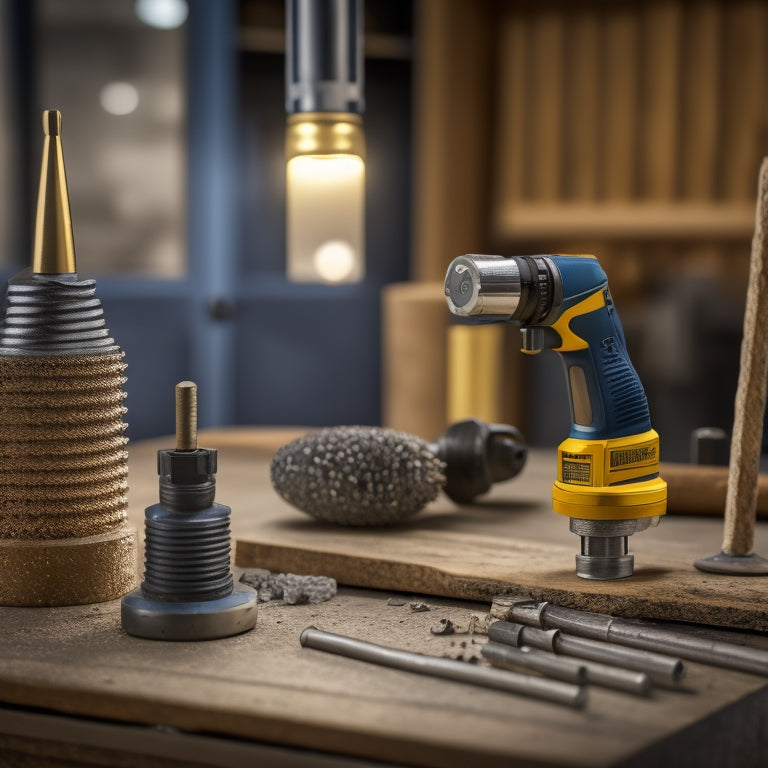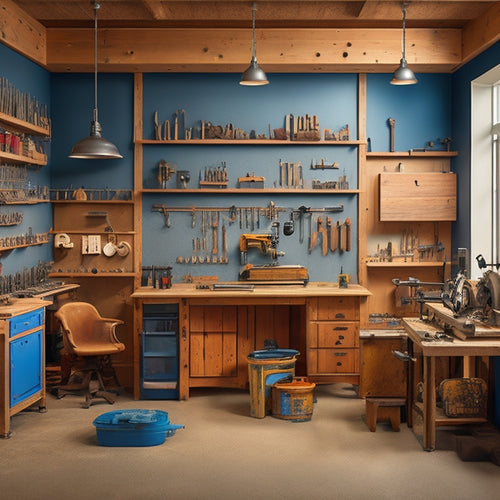
Top Drilling Bits for Home Renovation Projects
Share
When tackling a home renovation project, you'll need the right drilling bits to penetrate various materials efficiently and safely. Consider the material type, such as wood, metal, or concrete, and choose a bit that matches. High-Speed Steel (HSS) bits are suitable for general-purpose drilling, while Titanium Nitride (TiN) and Tungsten Carbide (TC) bits are ideal for tougher materials. For concrete, opt for hammer drill bits, diamond-coated bits, or carbide-tipped bits. Verify the bit size matches the screw or fastener being used. By selecting the right drill bit, you'll achieve professional-grade results and set yourself up for a successful renovation - and that's just the beginning of what you need to know.
Key Takeaways
- Choose drill bits based on material type, such as high-speed steel (HSS) for general-purpose drilling.
- Consider drill bit size and length for specific drilling tasks, including screw and fastener compatibility.
- Diamond-coated and tungsten carbide bits are ideal for tougher materials like concrete and stainless steel.
- Regularly inspect and clean drill bits to maintain effectiveness and extend lifespan.
- Store drill bits in a dry, cool place, using designated storage solutions to maintain organization and accessibility.
Choosing the Right Drill Bit
When tackling a home renovation project, how do you select the right drill bit for the task at hand, taking into account factors such as material, hole size, and desired finish?
You'll need to think about the type of material you're working with, whether it's wood, metal, or drywall. Drill bit materials play an essential role in determining the bit's performance and longevity. Common materials include high-speed steel (HSS), titanium nitride (TiN), and tungsten carbide (TC). HSS bits are suitable for general-purpose drilling, while TiN and TC bits are ideal for drilling through tougher materials like stainless steel and concrete.
Next, you'll need to reflect on the hole size you require. Drill bit sizes vary greatly, ranging from tiny pilot bits to large auger bits. Choose a bit that matches your desired hole size, taking into account the screw or fastener you'll be using.
Some bits, like step bits, can drill multiple hole sizes, while others, like Forstner bits, are designed for precise, flat-bottomed holes.
Types of Concrete Drill Bits
Drilling through concrete requires specialized bits designed to withstand the abrasive nature of this tough material, and you'll need to choose from a range of concrete drill bit types, including hammer drill bits, diamond-coated bits, and carbide-tipped bits, each with its own unique characteristics and applications.
| Drill Bit Type | Description |
|---|---|
| Hammer Drill Bits | Designed for use with hammer drills, these bits are ideal for drilling into concrete, brick, and block. |
| Diamond-Coated Bits | Coated with diamond particles, these bits are perfect for drilling through tough materials like concrete and masonry. |
| Carbide-Tipped Bits | Featuring a carbide tip, these bits are designed for drilling into concrete, brick, and block, and are known for their durability. |
| Diamond Core Bits | Used for drilling large holes in concrete, these bits feature a diamond-coated edge and are ideal for heavy-duty applications. |
| Masonry Bits | Designed for drilling into brick, block, and concrete, these bits are perfect for DIY projects and renovations. |
When choosing a concrete drill bit, consider the type of material you'll be drilling into and the size of the hole you need to create. By selecting the right bit for the job, you'll guarantee a precise and efficient drilling process.
Features to Consider for Drilling
With the right concrete drill bit in hand, you'll want to take into account several key features to guarantee a smooth and efficient drilling process, including the bit's material, flute design, and cooling system.
The material of the drill bit is vital, as it must be compatible with the type of concrete you're working with. For example, a carbide-tipped bit is ideal for drilling through reinforced concrete, while a diamond-coated bit is better suited for drilling through abrasive materials.
When it comes to flute design, a bit with a spiral flute will help to remove debris more efficiently, reducing the risk of overheating and increasing drill speed.
The cooling system is also important, as it helps to prevent the bit from overheating and reduces the risk of damage. Look for a bit with a built-in cooling system, such as a hollow shaft or a coolant-fed system.
Best Drill Bits for Concrete
Selecting the right drill bit for concrete is essential, and you'll find that top-rated options typically feature a combination of advanced materials and innovative designs that enable faster, more efficient drilling and longer bit life.
When it comes to drilling through concrete, you'll want to choose a bit that's specifically designed for this task.
Here are some of the best drill bits for concrete:
-
Diamond Core Bits: These bits use diamond-coated edges to grind through concrete, making them ideal for heavy-duty applications.
-
Masonry Bits: These bits feature a tungsten carbide tip and are designed for drilling through concrete, brick, and block.
-
Carbide-Tipped Bits: These bits use a carbide tip to drill through concrete and are often less expensive than diamond core bits.
- SDS-Plus Bits: These bits feature a specialized shank that fits into SDS-Plus drills, making them ideal for drilling through concrete with a hammer drill.
When choosing a drill bit for concrete, consider the type of project you're working on and the level of durability you need. Diamond core bits are ideal for heavy-duty applications, while masonry bits are better suited for smaller projects.
Safety Precautions for Drilling Concrete
When drilling concrete, you'll need to take specific safety precautions to protect yourself and guarantee a successful project.
First, you'll need to wear personal protective equipment (PPE) such as safety glasses, gloves, and a dust mask to prevent injury from flying debris and airborne particles.
Additionally, you'll need to carefully select the right drill bit for the job and prepare your workspace to minimize risks and maximize efficiency.
Personal Protective Equipment
You'll greatly reduce the risk of injury while drilling concrete by wearing the right personal protective equipment (PPE), which should always include safety glasses, a dust mask, gloves, and sturdy boots.
As you prepare to tackle your home renovation project, don't underestimate the importance of safety gear. Protective eyewear, in particular, is vital when drilling concrete, as it can shield your eyes from flying debris and dust.
Here are four essential PPE items to include in your safety arsenal:
-
Safety glasses: Choose glasses with a wraparound frame to protect your eyes from all angles.
-
Dust mask: Opt for a mask with a filter designed to capture fine particles, such as those generated by concrete drilling.
-
Gloves: Select gloves that provide grip, puncture resistance, and vibration reduction to prevent hand fatigue and injury.
- Sturdy boots: Wear boots with slip-resistant soles and ankle support to prevent falls and ankle sprains.
Drill Bit Selection
With your personal protective equipment in place, it's time to focus on choosing the right drill bit for your concrete drilling tasks, as the wrong bit can lead to inefficient drilling, increased risk of injury, and damage to your power tool. When selecting a drill bit, consider the type of concrete you're working with and the desired outcome. Drill bit materials play a vital role in determining the bit's lifespan and performance. Common materials include tungsten carbide, high-speed steel, and diamond-coated.
| Drill Bit Size | Recommended Use |
|---|---|
| 1/16' - 1/4' | Small holes for anchors or screws |
| 1/4' - 1/2' | Medium holes for pipes or conduit |
| 1/2' - 1' | Large holes for heavy-duty applications |
Drill bit sizes also vary, and choosing the right size is essential for efficient drilling. Using a bit that's too small can lead to increased drilling time and reduced accuracy, while a bit that's too large can cause damage to the surrounding concrete. By selecting the right drill bit material and size, you'll be able to complete your concrete drilling tasks safely and effectively.
Workspace Preparation
Regularly inspecting your workspace before drilling into concrete is essential to prevent accidents and guarantee a smooth drilling process. You'll want to make sure that your workspace is clear of clutter, tripping hazards, and flammable materials. A well-organized workspace not only reduces the risk of accidents but also improves your overall drilling efficiency.
To achieve ideal workspace organization, consider the following:
-
Clear the area: Remove any unnecessary items from the workspace, including tools, materials, and debris.
-
Designate tool storage: Assign a specific area for tool storage to keep your equipment organized and within reach.
-
Secure loose items: Make certain that any loose items, such as cords or hoses, are securely fastened to prevent tripping or entanglement.
- Protect the floor: Cover the floor with a drop cloth or old sheets to prevent damage from dust, debris, or spills.
Maintaining Your Drill Bits
To get the most out of your drill bits and prolong their lifespan, it is essential to develop a maintenance routine that includes proper cleaning, storage, and inspection after each use. You'll be surprised at how a little TLC can extend the life of your drill bits.
Drill Bit Maintenance Checklist
| Task | Description |
|---|---|
| Cleaning | Use a soft brush to remove debris and dust from the drill bit. For tougher residue, mix baking soda and water to create a paste, and apply it to the bit. Let it sit for 30 minutes before rinsing with warm water. |
| Storage | Store your drill bits in a dry, cool place, away from direct sunlight. Use a drill bit case or pouch to protect them from damage. |
| Inspection | Regularly inspect your drill bits for signs of wear, such as dullness, rust, or damage. Use sharpening techniques to restore the bit's cutting edge. |
Frequently Asked Questions
Can I Use a Masonry Bit on Glass or Tile?
You'll want to exercise caution when drilling into glass or tile.
While a masonry drill bit can be used on these surfaces, it's not the best option. Masonry bits are designed for drilling into concrete, brick, and stone, and can easily shatter or crack glass and tile.
For these surfaces, it's recommended to use a specialized glass cutting bit or a diamond-coated tile bit, which are specifically designed for smooth, precise cuts.
How Do I Remove a Stuck Drill Bit From Concrete?
When you're dealing with a stuck drill bit in concrete, don't panic. You'll need to carefully assess the situation before attempting removal.
First, stop drilling immediately to avoid further damage.
Next, try to loosen the bit by applying heat or penetrating oil to the affected area.
If that doesn't work, you may need to use a drill bit removal tool or a concrete drilling extractor to safely and effectively remove the stuck bit.
What Is the Best Drill Bit for Drilling Through Rebar?
You're tackling rebar like a firefighter taking on a blazing inferno - with precision and the right gear.
For drilling through rebar, you'll want a drill bit that's as tough as the steel it's cutting.
Look for bits made from high-speed steel (HSS) or tungsten carbide (TC), which can withstand the rigors of rebar drilling techniques.
These materials will help you power through rebar like a hot knife through butter, making your project a whole lot easier.
Can I Sharpen My Own Drill Bits at Home?
You're considering sharpening your own drill bits at home, but it's essential to understand the complexities involved.
Different drill bit materials require specific sharpening techniques. High-speed steel bits can be sharpened with a diamond stone or ceramic hone, while carbide-tipped bits need a diamond-coated sharpening wheel.
Cobalt steel bits, on the other hand, require a water-cooled sharpening system.
You'll need to invest in the right equipment and master the technique to achieve the best results.
How Often Should I Replace My Drill Bits?
When to replace your drill bits depends on bit maintenance and the type of drill bit you're using. You should regularly inspect your bits for wear and tear.
If you notice a decrease in drilling performance or an increase in heat buildup, it's time to replace them.
Typically, twist bits last for 10-50 holes, while step bits can make 20-100 holes.
Proper bit maintenance, like cleaning and storing, can extend their lifespan.
Conclusion
As you wrap up your home renovation project, your drill bits have been the unsung heroes, piercing through concrete like hot knives through butter.
With the right bits, you've conquered tough tasks with ease, precision, and control.
Now, as you put your tools to rest, remember to maintain those trusty drill bits, sharpening their edges and storing them safely, ready to release their fury on the next project that comes your way.
Related Posts
-

Streamlining Your Exterior Renovation Timeline
To streamline your exterior renovation timeline, start by identifying your project goals and objectives, and prioriti...
-

Renovation Tool Checklist for Smooth Finishes
When tackling a renovation project that requires a smooth finish, you'll need a thorough tool checklist to guarantee ...
-

Streamline Your Exterior Renovation Timeline
To streamline your exterior renovation timeline, you'll need to approach the process strategically. Start by planning...


